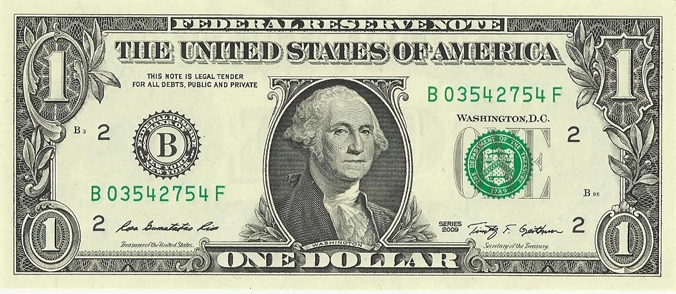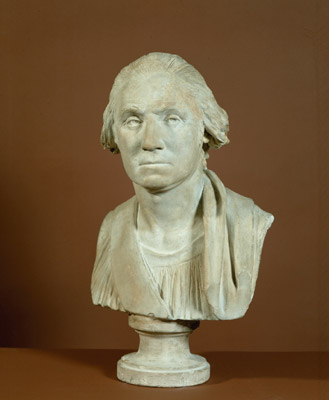When you hear the name George Washington, what is the first image that pops into your head? For many people, it is the picture of the first president that adorns the U.S. paper dollar, but have you ever wondered how he ended up there? Since today is National Dollar Day commemorating the day in 1786 when United States Congress established the dollar as the official unit of account for the federal government, we thought we’d briefly explore the history of George on the dollar.

The current $1 bill featuring George Washington. Credit: Public domain / Wikipedia
Although paper currency has been around for centuries, the practice was first used in western world around the 17th century. During the colonial era, physical money was quite scarce in the American Colonies; instead, the economy operated on a barter system using goods as payment for services. With the advent of the American Revolution, the Continental Congress began issuing paper money to help fund the war effort but the bills were not worth much and depreciated in value quickly. After the war, when writing the new U.S. Constitution, the form of currency for the new country would prove a priority. In fact, Article I, Section 10 of the Constitution gives only the United States Federal Government the power to coin money for the country and, by 1792, the U.S. Mint was established.
At the same time, states were still allowed to issue their own currency as well but they lacked accountability so many of them were worthless. Leading up to the Civil War, there were around 10,000 different kinds of paper money in circulation in the United States. Thus, throughout the early years of our country, foreign money and bartering were still widely used.
In fact, it was during the early 19th century that the slang term “buck” began being used. Henry Howe, an American author and traveler, wrote of his time on the Ohio frontier where “a muskrat skin was equal to a quarter of a dollar; a raccoon skin, a third of a dollar; a doe skin, half a dollar, and a buck skin, ‘the almighty dollar’”[1]. Thus, when referring to the price of something, many people referred to it as a “buck”.
During the Civil War, the United States government funded its war effort by printing new forms of currency. It was at this time that the first official paper currency was created. The federal government even printed fractional notes during the time because the metal normally used to make coins was needed for the war. One of the bills created at the time was the official one dollar bill in 1862. This early version of the bill featured then Secretary of the Treasury Salmon Chase.
The money printed during this time period became known as “greenbacks” because it was not backed by anything. The worth was simply given to it by the government saying it had worth. This meant that the government had to closely control printing and also find a way to prevent counterfeiting. Today, many people think of the U.S. Secret Service as the people who protect the President but the service was actually formed at this time to deal with counterfeiters.

An $1 note from 1880 featuring George Washington. Credit: Public domain / Wikipedia
After the Civil War, the U.S. Bureau of Engraving and Printing took over production of U.S. Currency. It was in 1869 that George Washington’s face first appeared on the one dollar bill. The design of the dollar changed quite a bit up until 1963 when the bill we recognize today was first created. Unlike most of the rest of our paper money, the one dollar bill has not been redesigned since then and there are no plans to do so.
Currency is redesigned at intervals to forestall counterfeiting. As recently as 2016, then Treasury Secretary Jacob Lew planned a complete redesign of the twenty dollar bill to replace Andrew Jackson with a picture of Harriet Tubman. Lew planned the design to be released in 2020 but it has been delayed until 2026.
Regardless, Tubman will not be the first woman featured on U.S. currency. We have had women (including Susan B. Anthony, Sacagawea, and Helen Keller) featured on U.S. coins. In the 1860s, Pocahontas was featured on the twenty dollar note. In the 1880s, Martha Washington was featured on the $1 silver certificate. This bill with the portrait of Martha Washington is the only time a woman has ever been on U.S. paper money as the primary portrait. Another series released in the 1890s was called the Educational Series and featured Martha next to her husband. Many coin collectors and currency experts consider it to be the most beautiful currency ever created by the United States Government. It was shortly after this that our paper money shifted to what we know it as today with denominations of one, five, ten, twenty, fifty, and one hundred becoming the most commonly used bills.

The $1 silver certificate from 1886 featuring Martha Washington. Credit: Public domain / Wikipedia.
The U.S. Currency Education Program says around twelve billion one dollar bills are in circulation as of 2017. That’s a lot of Georges. Ironically, the portrait appearing on the bill, is one that the man himself was likely not particularly fond of. Painted by Gilbert Stuart in 1796, it is often referred to as The Athenaeum Portrait. Today, the original painting is on display at the National Portrait Gallery in Washington D.C. Despite being the most recognized painting of George, it is an unfinished work. In the painting, George’s cheeks are puffed out and his lips pursed in discomfort. Around the same time he complained about his new set of dentures not fitting him correctly and causing him pain. Due to his constant concern for his appearance and demeanor, he would probably not appreciate our widespread use of this portrait. He probably much preferred the bust created by Jean-Antoine Houdon, something even his family said was the most accurate likeness of him.

Gilbert Stuart’s “Athenaeum Portrait” (L) vs the $1 bill portrait (R). Credit: Anna Frodesiak / Wikipedia

Bust of George Washington created by Jean-Antoine Houdon and widely considered the most accurate likeness of Washington. Credit: National Portrait Gallery
Elizabeth Hosier
Manager of Interpretation and Visitor Services
[1] Howe, H. (1851). Historical collections of Ohio. Cincinnati: H. Howe at E. Morgan & co’s.